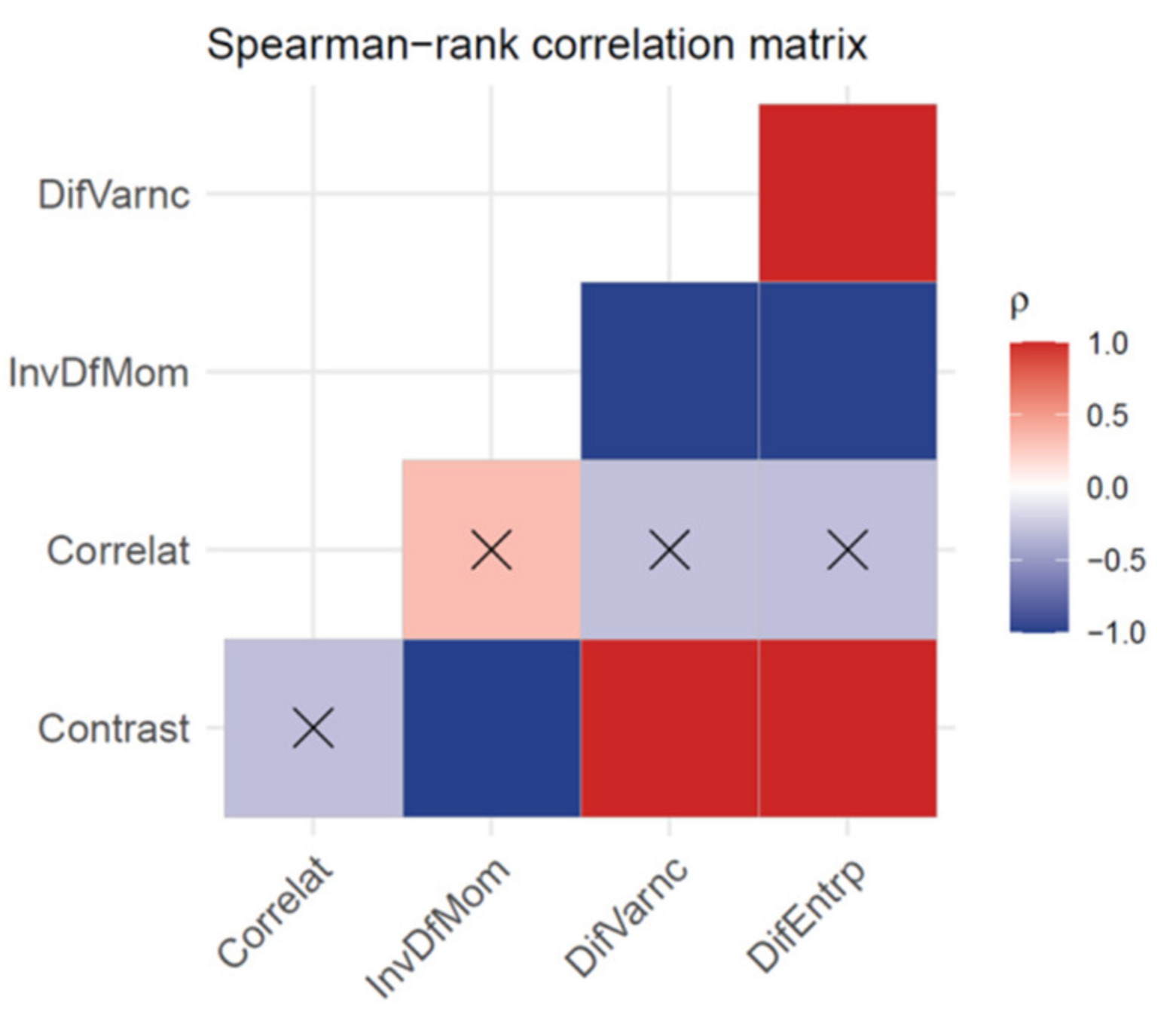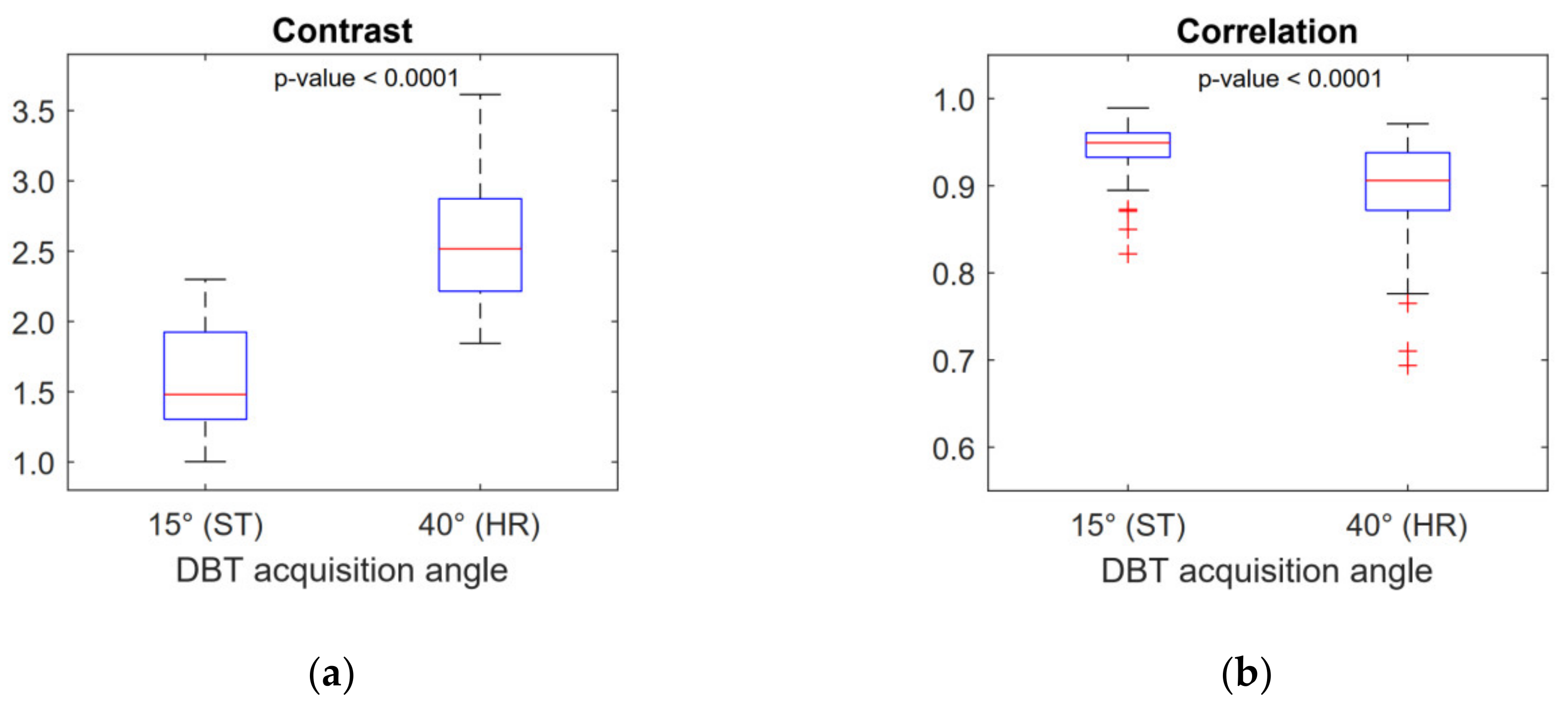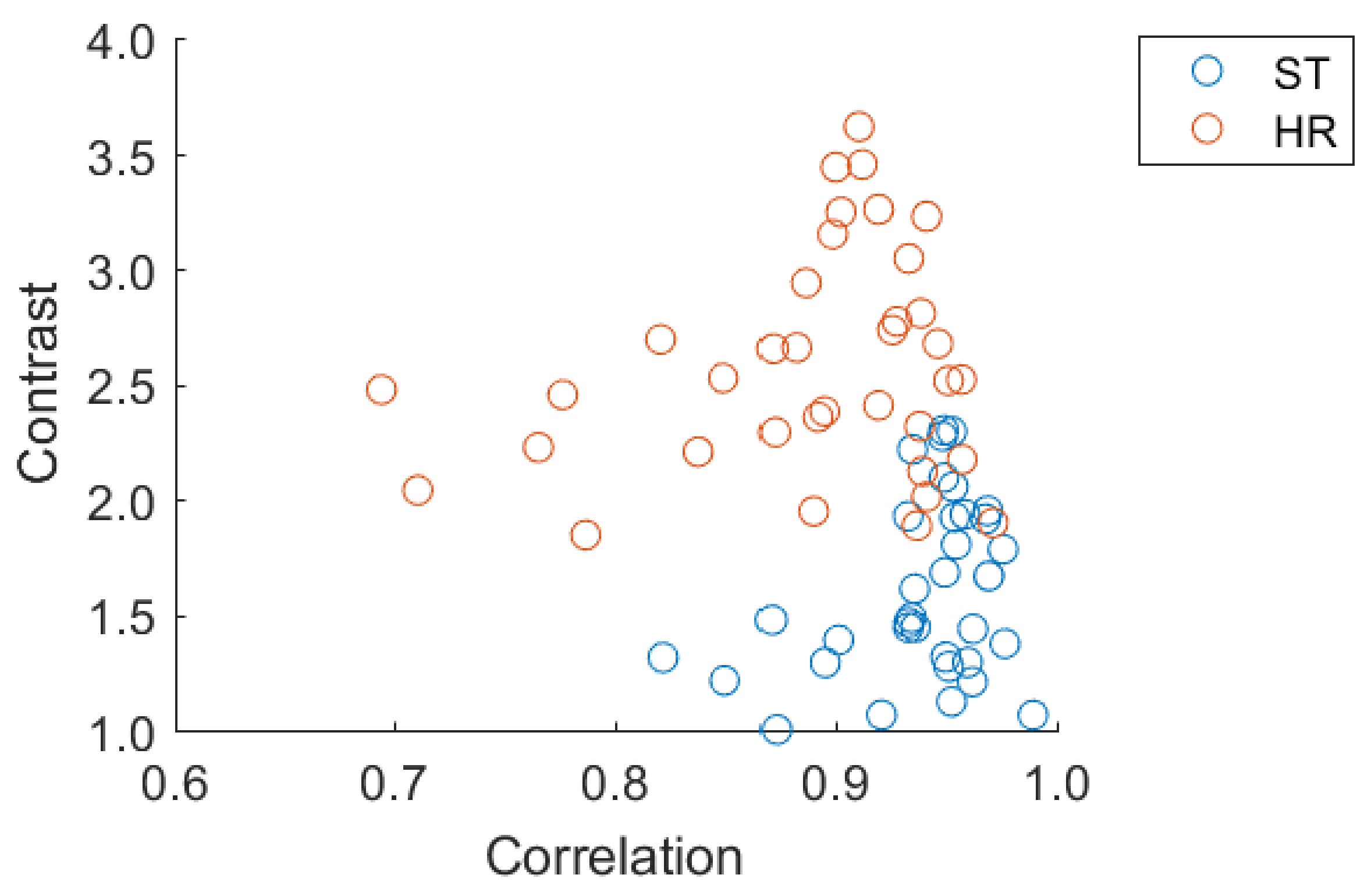The Role of Acquisition Angle in Digital Breast Tomosynthesis: A Texture Analysis Study
Abstract
1. Introduction
2. Materials and Methods
3. Results
4. Discussion
5. Conclusions
Supplementary Materials
Author Contributions
Funding
Acknowledgments
Conflicts of Interest
References
- Lambin, P.; Rios-Velazquez, E.; Leijenaar, R.; Carvalho, S.; Van Stiphout, R.G.P.M.; Granton, P.; Zegers, C.M.L.; Gillies, R.; Boellard, R.; Dekker, A.; et al. Radiomics: Extracting more information from medical images using advanced feature analysis. Eur. J. Cancer 2012, 48, 441–446. [Google Scholar] [CrossRef]
- Larue, R.T.H.M.; Defraene, G.; De Ruysscher, D.; Lambin, P.; Van Elmpt, W. Quantitative radiomics studies for tissue characterization: A review of technology and methodological procedures. Br. J. Radiol. 2017, 90, 20160665. [Google Scholar] [CrossRef]
- Petrosian, A.; Heang-Ping, C.; Helvie, M.A.; Goodsitt, M.M.; Adler, D.D. Computer-aided diagnosis in mammography: Classification of mass and normal tissue by texture analysis. Phys. Med. Biol. 1994, 39, 2273–2288. [Google Scholar] [CrossRef]
- Chan, H.P.; Sahiner, B.; Petrick, N.; Helvie, M.A.; Lam, K.L.; Adler, D.D.; Goodsitt, M.M. Computerized classification of malignant and benign microcalcifications on mammograms: Texture analysis using an artificial neural network. Phys. Med. Biol. 1997, 42, 549–567. [Google Scholar] [CrossRef]
- Karahaliou, A.N.; Boniatis, I.S.; Skiadopoulos, S.G.; Sakellaropoulos, F.N.; Arikidis, N.S.; Likaki, E.A.; Panayiotakis, G.S.; Costaridou, L.I. Breast cancer diagnosis: Analyzing texture of tissue surrounding microcalcifications. IEEE Trans. Inf. Technol. Biomed. 2008, 12, 731–738. [Google Scholar] [CrossRef]
- Karahaliou, A.; Skiadopoulos, S.; Boniatis, I.; Sakellaropoulos, P.; Likaki, E.; Panayiotakis, G.; Costaridou, L. Texture analysis of tissue surrounding microcalcifications on mammograms for breast cancer diagnosis. Br. J. Radiol. 2007, 80, 648–656. [Google Scholar] [CrossRef]
- Pereira, R.R.; Azevedo Marques, P.M.; Honda, M.O.; Kinoshita, S.K.; Engelmann, R.; Muramatsu, C.; Doi, K. Usefulness of texture analysis for computerized classification of breast lesions on mammograms. J. Digit. Imaging 2007, 20, 248–255. [Google Scholar] [CrossRef]
- Li, H.; Giger, M.L.; Olopade, O.I.; Margolis, A.; Lan, L.; Chinander, M.R. Computerized texture analysis of mammographic parenchymal patterns of digitized mammograms1. Acad. Radiol. 2005, 12, 863–873. [Google Scholar] [CrossRef] [PubMed]
- Ma, W.; Zhao, Y.; Ji, Y.; Guo, X.; Jian, X.; Liu, P.; Wu, S. Breast cancer molecular subtype prediction by mammographic radiomic features. Acad. Radiol. 2019, 26, 196–201. [Google Scholar] [CrossRef]
- Li, Z.; Yu, L.; Wang, X.; Yu, H.; Gao, Y.; Ren, Y.; Wang, G.; Zhou, X. Diagnostic performance of mammographic texture analysis in the differential diagnosis of benign and malignant breast tumors. Clin. Breast Cancer 2018, 18, e621–e627. [Google Scholar] [CrossRef]
- Kontos, D.; Bakic, P.R.; Carton, A.K.; Troxel, A.B.; Conant, E.F.; Maidment, A.D.A. Parenchymal texture analysis in digital breast tomosynthesis for breast cancer risk estimation. A preliminary study. Acad. Radiol. 2009, 16, 283–298. [Google Scholar] [CrossRef][Green Version]
- Kontos, D.; Ikejimba, L.; Bakic, P. Analysis of parenchymal texture with digital breast tomosynthesis: Comparison with digital mammography and implications for cancer risk assessment. Radiology 2011, 261, 80–91. [Google Scholar] [CrossRef][Green Version]
- Sechopoulos, I.; Ghetti, C. Optimization of the acquisition geometry in digital tomosynthesis of the breast. Med. Phys. 2009, 36, 1199–1207. [Google Scholar] [CrossRef]
- Li, B.; Avinash, G.B.; Uppaluri, R.; Eberhard, J.W.; Claus, B.E.H. The impact of acquisition angular range on the z-resolution of radiographic tomosynthesis. Int. Congr. Ser. 2004, 1268, 13–18. [Google Scholar] [CrossRef]
- Goodsitt, M.M.; Chan, H.P.; Schmitz, A.; Zelakiewicz, S.; Telang, S.; Hadjiiski, L.; Watcharotone, K.; Helvie, M.A.; Paramagul, C.; Neal, C.; et al. Digital breast tomosynthesis: Studies of the effects of acquisition geometry on contrast-to-noise ratio and observer preference of low-contrast objects in breast phantom images. Phys. Med. Biol. 2014, 59, 5883–5902. [Google Scholar] [CrossRef]
- Reiser, I.; Nishikawa, R.M. Task-based assessment of breast tomosynthesis: Effect of acquisition parameters and quantum noise. Med. Phys. 2010, 37, 1591–1600. [Google Scholar] [CrossRef]
- Lee, C.; Han, M.; Baek, J. Human observer performance on in-plane digital breast tomosynthesis images: Effects of reconstruction filters and data acquisition angles on signal detection. PLoS ONE 2020, 15, 1–20. [Google Scholar] [CrossRef]
- Han, D. Comparison of commonly used image interpolation methods. In Proceedings of the 2nd International Conference on Computer Science and Electronics Engineering, Hangzhou, China, 22–23 March 2013; pp. 1556–1559. [Google Scholar] [CrossRef]
- Parker, J.A.; Kenyon, R.V.; Troxel, D.E. Comparison of interpolating methods parker kenyon troxel. IEEE Trans. Med. Imaging 1983, 2, 31–39. [Google Scholar] [CrossRef]
- Larue, R.T.H.M.; van Timmeren, J.E.; de Jong, E.E.C.; Feliciani, G.; Leijenaar, R.T.H.; Schreurs, W.M.J.; Sosef, M.N.; Raat, F.H.P.J.; van der Zande, F.H.R.; Das, M.; et al. Influence of gray level discretization on radiomic feature stability for different CT scanners, tube currents and slice thicknesses: A comprehensive phantom study. Acta Oncol. (Madr) 2017, 56, 1544–1553. [Google Scholar] [CrossRef]
- Li, H.; Giger, M.L.; Huo, Z.; Olopade, O.I.; Lan, L.; Weber, B.L.; Bonta, L. Computerized analysis of mammographic parenchymal patterns for assessing breast cancer risk: Effect of ROI size and location. Med. Phys. 2004, 31, 549–555. [Google Scholar] [CrossRef]
- Szczypiński, P.M.; Strzelecki, M.; Materka, A.; Klepaczko, A. MaZda-A software package for image texture analysis. Comput. Methods Programs Biomed. 2009, 94, 66–76. [Google Scholar] [CrossRef]
- Haralick, R.M.; Shanmugam, K.; Dinstein, I. Textural features for image classification. IEEE Trans. Syst. Man Cybern. 1973, SMC-3, 610–621. [Google Scholar] [CrossRef]
- Gupta, S.; Markey, M.K. Correspondence in texture features between two mammographic views. Med. Phys. 2005, 32, 1598–1606. [Google Scholar] [CrossRef]
- Rangayyan, R.M.; Nguyen, T.M.; Ayres, F.J.; Nandi, A.K. Effect of pixel resolution on texture features of breast masses in mammograms. J. Digit. Imaging 2010, 23, 547–553. [Google Scholar] [CrossRef]
- Zheng, Y.; Keller, B.M.; Ray, S.; Wang, Y.; Conant, E.F.; Gee, J.C.; Kontos, D. Parenchymal texture analysis in digital mammography: A fully automated pipeline for breast cancer risk assessment. Med. Phys. 2015, 42, 4149–4160. [Google Scholar] [CrossRef]
- Kamra, A.; Jain, V.K.; Singh, S.; Mittal, S. Characterization of architectural distortion in mammograms based on texture analysis using support vector machine classifier with clinical evaluation. J. Digit. Imaging 2016, 29, 104–114. [Google Scholar] [CrossRef]
- Tagliafico, A.S.; Valdora, F.; Mariscotti, G.; Durando, M.; Nori, J.; La Forgia, D.; Rosenberg, I.; Caumo, F.; Gandolfo, N.; Houssami, N.; et al. An exploratory radiomics analysis on digital breast tomosynthesis in women with mammographically negative dense breasts. Breast 2018, 40, 92–96. [Google Scholar] [CrossRef]
- Sechopoulos, I. A review of breast tomosynthesis. Part II. Image reconstruction, processing and analysis, and advanced applications. Med. Phys. 2013, 40, 014302. [Google Scholar] [CrossRef]
- Ortenzia, O.; Rossi, R.; Bertolini, M.; Nitrosi, A.; Ghetti, C. Physical characterisation of four different commercial digital breast tomosynthesis systems. Radiat. Prot. Dosimetry 2018, 181, 277–289. [Google Scholar] [CrossRef]





| First-Order Features (Histogram) | Mean |
| Variance | |
| Skewness | |
| Kurtosis | |
| Second-Order Features (GLCM) | Angular Second Moment |
| Contrast | |
| Correlation | |
| Sum of Squares | |
| Inverse Difference Moment | |
| Sum Average | |
| Sum Variance | |
| Sum Entropy | |
| Entropy | |
| Difference Variance | |
| Difference Entropy |
| % Difference 40°–15° Acquisition Angle (p < 0.05) | ||
|---|---|---|
| First-Order Features (Histogram) | ||
| Second-Order Features (GLCM) | Contrast | +50% |
| Correlation | −5% | |
| Inverse Difference Moment | −14% | |
| Difference Variance | +45% | |
| Difference Entropy | +17% |
© 2020 by the authors. Licensee MDPI, Basel, Switzerland. This article is an open access article distributed under the terms and conditions of the Creative Commons Attribution (CC BY) license (http://creativecommons.org/licenses/by/4.0/).
Share and Cite
Savini, A.; Feliciani, G.; Amadori, M.; Rivetti, S.; Cremonesi, M.; Cesarini, F.; Licciardello, T.; Severi, D.; Ravaglia, V.; Vagheggini, A.; et al. The Role of Acquisition Angle in Digital Breast Tomosynthesis: A Texture Analysis Study. Appl. Sci. 2020, 10, 6047. https://doi.org/10.3390/app10176047
Savini A, Feliciani G, Amadori M, Rivetti S, Cremonesi M, Cesarini F, Licciardello T, Severi D, Ravaglia V, Vagheggini A, et al. The Role of Acquisition Angle in Digital Breast Tomosynthesis: A Texture Analysis Study. Applied Sciences. 2020; 10(17):6047. https://doi.org/10.3390/app10176047
Chicago/Turabian StyleSavini, Alessandro, Giacomo Feliciani, Michele Amadori, Stefano Rivetti, Marta Cremonesi, Francesco Cesarini, Tiziana Licciardello, Daniela Severi, Valentina Ravaglia, Alessandro Vagheggini, and et al. 2020. "The Role of Acquisition Angle in Digital Breast Tomosynthesis: A Texture Analysis Study" Applied Sciences 10, no. 17: 6047. https://doi.org/10.3390/app10176047
APA StyleSavini, A., Feliciani, G., Amadori, M., Rivetti, S., Cremonesi, M., Cesarini, F., Licciardello, T., Severi, D., Ravaglia, V., Vagheggini, A., Sarnelli, A., & Falcini, F. (2020). The Role of Acquisition Angle in Digital Breast Tomosynthesis: A Texture Analysis Study. Applied Sciences, 10(17), 6047. https://doi.org/10.3390/app10176047





